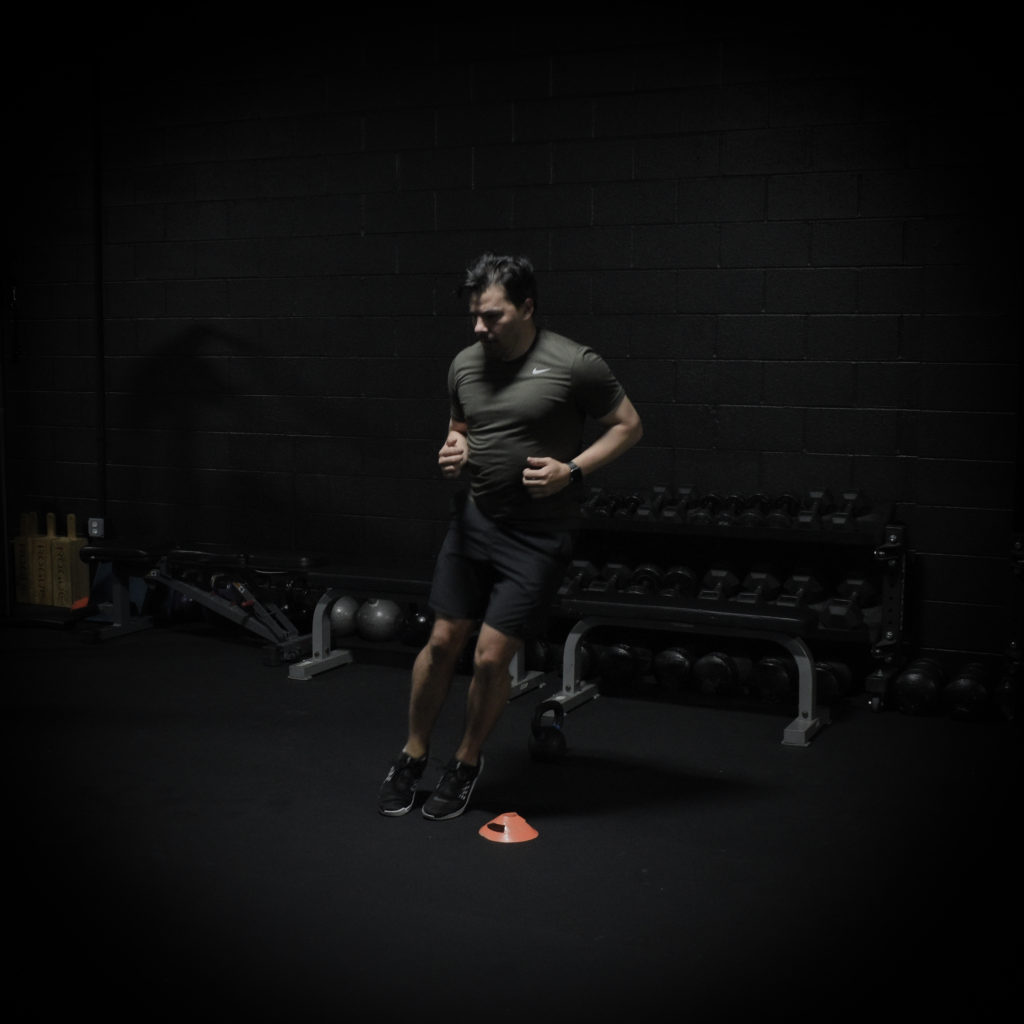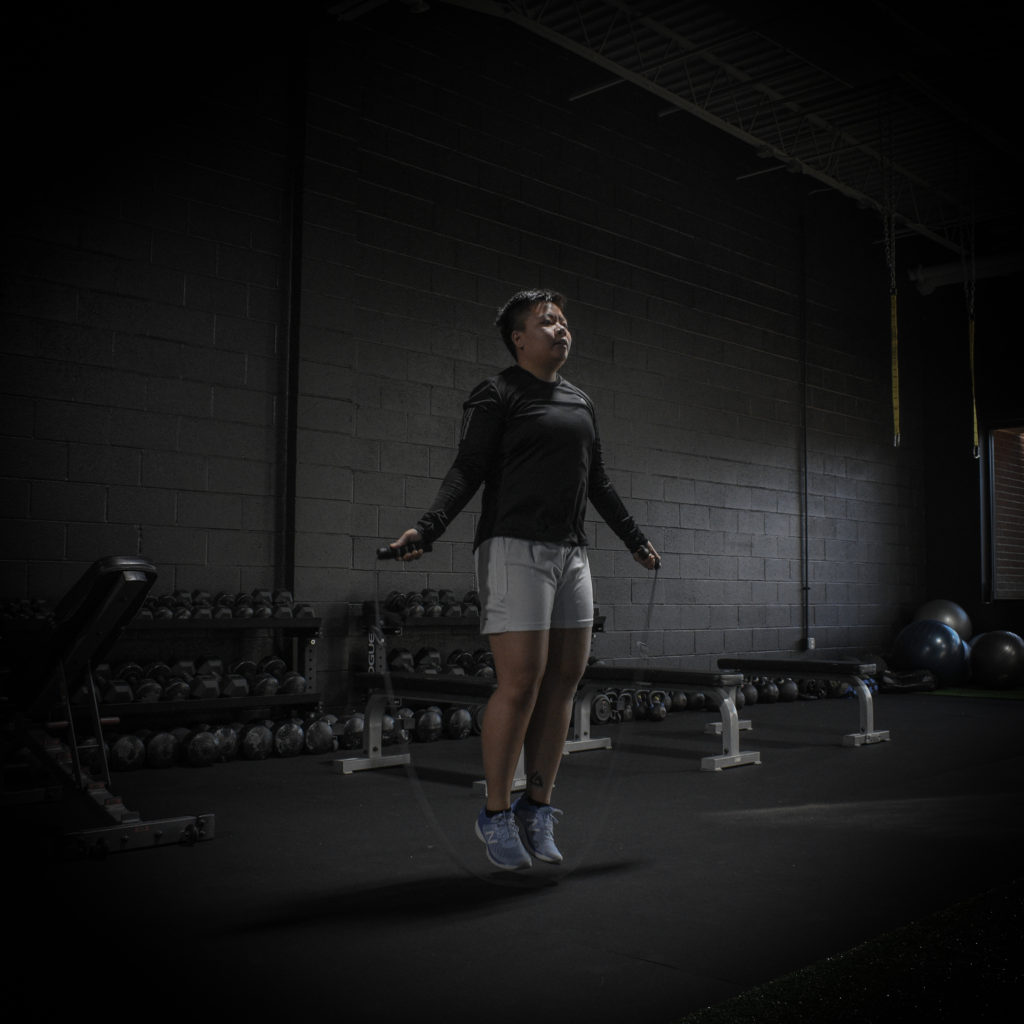This month’s endurance class includes a bunch of low-threshold plyometrics. These are reactive hopping exercises that require minimal height while jumping. Examples: jumping rope, side-to-side line hops, and low rebound jumps. They’re great for building tissue tolerance to prep for running, hiking, and rucking. And that’s why we include them—so our bodies get used to redirecting force while we are working at a moderate pace.

But you might have noticed that your heart rate jumps quite a bit while doing them. Well, I’m about to explain why and tell you what to do to keep that from happening.
Why Your Heart Rate Jumps Like a Sinner at a Church Revival
A wise old goat once told me that your heart rate jumps while you jump because you’re naughty and you’re being punished for your sins. The Almighty knows it and he’s trying pop the demons out of your body. Don’t blame me or the old goat; blame yourself.
While the above is a plausible explanation, there are scientific explanations that might get a little closer to the real reason. And, truth is, I’d rather you not spend the rest of your day lamenting over a lifetime’s worth of potential rights and wrongs. You’re human. Sometimes humans do weird things – like steal every salt shaker from every restaurant you’ve ever been to. That is an example, not a confession of guilt.

So, the first reason is that low-threshold plyometrics increase your blood pressure. Increases in blood pressure raise your heart rate. That happens with any exercise to varying degrees. Strength training is another example. You create pressure in your thoracic cavity, your muscles create pressure by contracting, and your heart has to do more work to pump out oxygenated blood. Voila, your heart rate increases. Even if you’re super fit, you’ll see your heart rate increase while doing low-threshold plyometrics. The crux, however, is how much your heart rate increases.
Some of your heart rates are rising into the 160s or 170s while you do your hippity hops. That’s not what we want. The goal is to keep your ticker at under 150 beats per minute during the entire workout. Why such a high jump in heart rate?
You might be slightly dehydrated when you start the workout. Dehydration increases your heart rate because you don’t have as much blood volume. With less blood volume, your heart works harder to pump blood throughout the body. Make sure you drink your water, kids.
There’s also a good chance that you’re holding your breath or that your breathing cadence is off in some way while you jump. Remember the thoracic pressure we talked about earlier? Holding your breath increases thoracic pressure, which increases blood pressure, which increases heart rate. Your blood also doesn’t have as much oxygen as it otherwise would, so your heart has to work harder to deal out the oxygen that is available.

Another reason is that each hop costs you more than it should. That means that your relative strength and power is low. The process of landing, gathering force, and redirecting that force requires too much effort on your part. That increase in effort causes an increase in demand for oxygen and nutrients. Then your heart rate increases to meet the demand.
Let’s talk about what to do to keep your heart rate down during low-threshold plyos.
Slowing Down Your Ticker During Plyos
Start by making sure you’re drinking enough water. You need at least half your body weight in ounces per day. If you’re a 150-pound person, you need to drink 75 ounces of water at baseline. As your activity increases, so should your water intake. Without enough blood volume, your heart rate chronically elevates. Then it elevates even more during exercise.

Keep your body mostly relaxed and breathe while you hop. This will keep oxygen flowing and limit the amount of pressure exerted on your heart and lungs. Have you ever seen a pimp walk? Loosey goosey, baby. Be reactive with your feet, but loosey goosey everywhere else. Keep pimpin’.
Training to improve your relative strength and power is the long-term play. In the short-term, you need to increase your ground contact time slightly to account for the increased effort. That means, slow down during your plyo sets and don’t try to do reps as fast as possible. It might feel painfully slow, but as you improve with efficiency, you’ll be able to go faster. For now, slow down and increase your ground contact time, or time that your feet are on the ground.
One more tactic: Slow down between exercises. If you start your plyos with your heart rate already accelerated, it’s going to jump out of the cardiac output zone (~100bpm to 150bpm). We don’t want this. Remember, everyone will move through this workout at a different pace, and you need to move through it at the pace that’s right for you. And that’s the one that keeps your heart rate under 150bpm. If necessary, rest between exercises until your heart is 160 minus your age.
Stay hydrated. Keep it pimpin’. Increase your ground contact time. Slow down between exercises. Do these things and you’ll not need to exorcise the demons.
You might also like:
- WANT TO MAKE PROGRESS? PUT SOMETHING HARD ON THE CALENDAR
- STRENGTH LOVES REST: WHY YOU NEED LONGER REST PERIODS TO BUILD STRENGTH
- HOW TO RECOVER FROM YOUR WORKOUTS
- WHY IT’S IMPORTANT TO COOL DOWN AFTER TRAINING
- MORPHEUS HEART RATE TRAINING: WHAT IT IS, WHY WE USE IT, AND HOW YOU CAN GET THE MOST OUT OF IT
- START NOW: WHY WAITING FOR THE PERFECT TIME IS THE WORST THING TO DO
- HOW TO BE INTELLIGENT WITH YOUR WEIGHT SELECTION
- HOW TO PROGRESS YOUR WEIGHTS DURING A STRENGTH PROGRAM
- HOW (AND WHY) OUR YEAR-LONG TRAINING PLAN WORKS
- WHY WE TEST AR BEYOND STRENGTH
- TIPS FOR COMPETING WITH YOURSELF IN THE GYM
- HOW MANY REPS SHOULD YOU DO? (Spoiler alert, it matters in more ways than you think)
